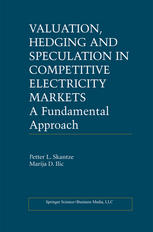

Most ebook files are in PDF format, so you can easily read them using various software such as Foxit Reader or directly on the Google Chrome browser.
Some ebook files are released by publishers in other formats such as .awz, .mobi, .epub, .fb2, etc. You may need to install specific software to read these formats on mobile/PC, such as Calibre.
Please read the tutorial at this link: https://ebookbell.com/faq
We offer FREE conversion to the popular formats you request; however, this may take some time. Therefore, right after payment, please email us, and we will try to provide the service as quickly as possible.
For some exceptional file formats or broken links (if any), please refrain from opening any disputes. Instead, email us first, and we will try to assist within a maximum of 6 hours.
EbookBell Team

0.0
0 reviewsThe challenges currently facing particIpants m competitive electricity markets are unique and staggering: unprecedented price volatility, a crippling lack of historical market data on which to test new modeling approaches, and a continuously changing regulatory structure. Meeting these challenges will require the knowledge and experience of both the engineering and finance communities. Yet the two communities continue to largely ignore each other. The finance community believes that engineering models are too detailed and complex to be practically applicable in the fast changing market environment. Engineers counter that the finance models are merely statistical regressions, lacking the necessary structure to capture the true dynamic properties of complex power systems. While both views have merit, neither group has by themselves been able to produce effective tools for meeting industry challenges. The goal of this book is to convey the fundamental differences between electricity and other traded commodities, and the impact these differences have on valuation, hedging and operational decisions made by market participants. The optimization problems associated with these decisions are formulated in the context of the market realities of today's power industry, including a lack of liquidity on forward and options markets, limited availability of historical data, and constantly changing regulatory structures.